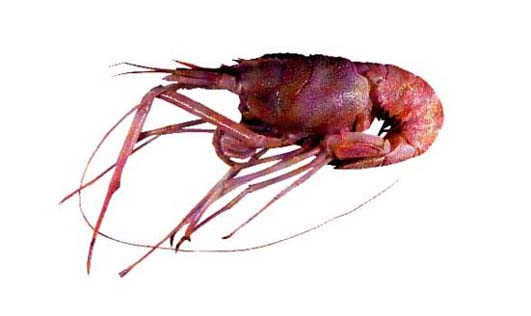アカザエビ科(Nephropidae)

ヤスリアカザエビ(Atlantic deep-sea lobster)
Acanthacaris caeca (A. Milne Edwards, 1881)
特 徴:
体長40cm。大形種で,頭胸甲,腹甲とも細かいとげでおおわれてやすり状を呈する。とげは頭胸甲では甲面に沿って前方を向き,腹甲では後方を向く。頭胸甲の正中線には中央部の溝の前方に1列,後方に約2列のやや大きいとげが並んでいる。また,額角側縁からは頸溝の上端まで稜が発達し,4,5本の大きなとげが並んでいるが,後方のものほど小さい。額角は頭胸甲長の1/2ほどで,基部側縁に1本,上縁に2,3本,下縁に6〜9本のとげがある。触角上棘は強く,後方に稜がのびる。触角溝は頸溝に連絡し,また,肝溝ともつながって頸後溝として上方にのびるが,左右の溝が頭胸甲の背縁でつながることはない。眼柄は短くて額角の下部に位置し,角膜は機能的ではない。第1胸脚は長大で,やすり状の小さなとげでおおわれ,また,長節後縁に大きなとげが並び,はさみには長いとげ状歯の間に短いとげが数本ずつある。腹部に特別の彫刻はない。尾節は角ばり,中央に縦溝がある。
採集記録:
水深650m(1♂)。
分 布:
従来の記録はメキシコ湾およびカリブ海沿岸の水深293〜878m。
備 考:
本属のもう1種はインド西太平洋海域産のA. tenuimana Bateである。
Diagnostic characters:
A large species thickly covered with fine spines which are directed forward on carapace and backward on abdomen; dorsal median line of carapace with a distinct row of spines on its anterior part and indistinct two rows on its posterior part; a submedian ridge running from each lateral margin of rostrum with four or five large spines; antennal spine distinct and followed by a short ridge; antennal, cervical and hepatic grooves united and then extended obliquely backward and upward as postcervical groove. Rostrum about half as long as carapace, being armed with one spine on each proximal lateral part, two or three on upper margin, and six to nine spines on lower margin. First pereiopod long and covered thickly with spinules, being armed with spines on lower margin of merus; cutting edges with very sharp spines, especially some equidistant ones being much larger.
Distribution:
Previously known from the Gulf of Mexico and the Caribbean Sea, 293-878 m deep.
Remarks:
Another representative of the genus, A. tenuimana Bate, is the inhabitant of the Indo-West Pacific.